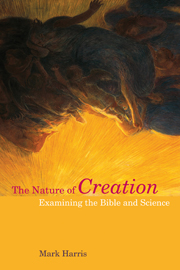Book contents
- Frontmatter
- Contents
- Preface
- Abbreviations
- 1 Introduction
- 2 Creation According to Modern Science
- 3 Creation According to the Bible I: Genesis
- 4 Creation According to the Bible II: The Creation Motif
- 5 The Framework of Biblical Cration
- 6 Creator–creation: How can a Ralationship be Described?
- 7 The Fall
- 8 Suffering and Evil
- 9 Scientific Eschatology and New Creation
- 10 Conclusions
- Bibliography
- Index of Ancient Citations
- Index
2 - Creation According to Modern Science
- Frontmatter
- Contents
- Preface
- Abbreviations
- 1 Introduction
- 2 Creation According to Modern Science
- 3 Creation According to the Bible I: Genesis
- 4 Creation According to the Bible II: The Creation Motif
- 5 The Framework of Biblical Cration
- 6 Creator–creation: How can a Ralationship be Described?
- 7 The Fall
- 8 Suffering and Evil
- 9 Scientific Eschatology and New Creation
- 10 Conclusions
- Bibliography
- Index of Ancient Citations
- Index
Summary
THE SCIENTIFIC FRAMEWORK
Space, time and matter
Our attitudes towards space and time are deeply ingrained, and we rarely question them. St Augustine famously noted in his Confessions that, in our everyday conversation, no word is more familiar or more readily understood than that of “time”. But if we ask ourselves what is “time”, we quickly find ourselves baffled. “I know well enough what it is, provided that nobody asks me”, says Augustine (Confessions XI: 14). And when he tries to define time, he does so in terms of events and happenings relative to himself: “I can confidently say that I know that if nothing passed, there would be no past time; if nothing were going to happen, there would be no future time; and if nothing were, there would be no present time.” This is significant, because Augustine has little of the sense of absolute time as a universal entity, an idea which is perhaps more familiar to us as a result of Newton.
For Newton, both space and time were absolute and independent of any local frame of reference. They were universal, and in this way Newton was able to define motion as the movement of an object relative to a fixed frame of reference, of both space and time. Space and time effectively became a fixed matrix in which all events and beings could be seen to exist, move and operate. Newton did not, however, go so far as to think of space and time as inseparably connected into one entity, “spacetime”.
Information
- Type
- Chapter
- Information
- The Nature of CreationExamining the Bible and Science, pp. 15 - 34Publisher: Acumen PublishingPrint publication year: 2013
